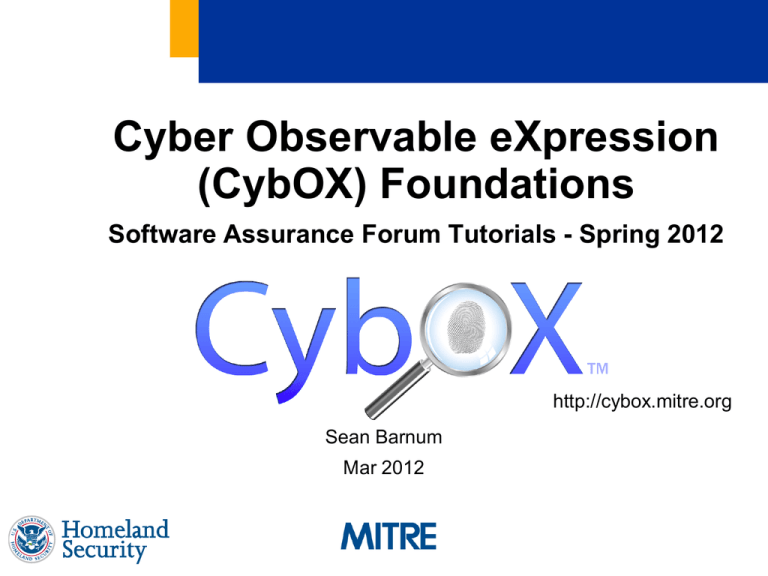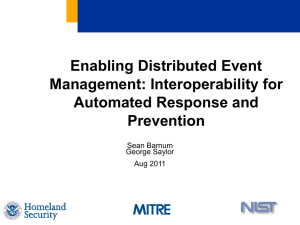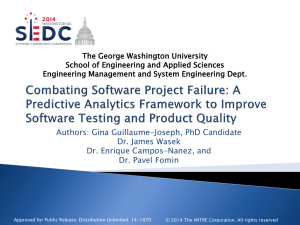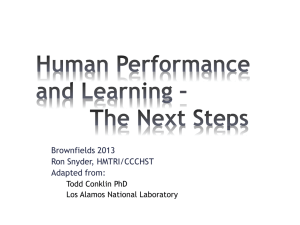
Cyber Observable eXpression
(CybOX) Foundations
Software Assurance Forum Tutorials - Spring 2012
http://cybox.mitre.org
Sean Barnum
Mar 2012
Agenda
■ What are cyber observables and why should we care?
■ CybOX in a nutshell
■ CybOX capabilities/structure
■ CybOX use cases/examples
■ CybOX status
■ CybOX for Indicator & Incident sharing
– Detailed real world example
UNCLASSIFIED
© 2010 The MITRE Corporation. All rights reserved.
Cyber Security Requires a Diverse Set of Activities
■ Secure Operations
– Understand Attacker Behavior
– What
Codifydoes
attack
it look
patterns
like?
– Detect & Prevent Attacks
– What
ID & IP
does it look like?
– Investigate & Address Attacks
– What
Incident
does
Management
it look like?
– High Fidelity Investigation
– What
Digitaldoes
Forensics
it look like?
– Find and Understand Malware
– What
Malware
does
Detection
it look like?
& Analysis
– How do we know what has happened?
– What
Logging
does it look like?
– How do we know what is happening?
– What
Eventdoes
Management
it look like?
– How do we feed risk decisions with
situational awareness?
– What
Continuous
does itMonitoring
look like?
– How do we share threat info?
– What
Structured
does it
Threat
look like?
Sharing
Cyber Observables are focused at answering this question
■ Secure Development
– How do we build security in?
– What
Security
does
Engineering
it look like?
– How do we make sure security works?
– What
Security
does
Assurance
it look like?
UNCLASSIFIED
© 2010 The MITRE Corporation. All rights reserved.
■ What is a cyber observable?
– a measurable event or stateful property in the cyber domain
■
Some measurable events: a registry key is created, a file is deleted,
an http GET is received, …
■
Some stateful properties: MD5 hash of a file, value of a registry key,
existence of a mutex, …
■ Cyber Observable eXpression (CybOX) is a standardized
language for encoding and communicating information
about cyber observables (http://cybox.mitre.org)
Page 4
UNCLASSIFIED
© 2010 The MITRE Corporation. All rights reserved.
Cyber Observables Apply to Numerous Domains
■ Threat assessment & characterization (detailed
attack patterns)
■ Malware characterization
■ Operational event management
■ Logging
■ Cyber situational awareness
■ Incident Response
■ Digital Forensics
■ Cyber Threat information sharing
■ Etc.
UNCLASSIFIED
© 2010 The MITRE Corporation. All rights reserved.
CybOX Principles
■ Targeted Gestalt
– CybOX is not targeted at a single cyber security use case but rather is
intended to be flexible enough to offer a common solution for all cyber
security use cases requiring the ability to deal with cyber observables.
It is primarily intended as a piece of information infrastructure that
domain-specific standards and solutions can build upon.
■ Flexibility to express both instances and apriori potential patterns
– It is also intended to be flexible enough to allow both the high-fidelity
description of instances of cyber observables that have been measured
in an operational context as well as more abstract patterns for potential
observables that may be targets for observation and analysis apriori.
■ Integrated automation vision
– By specifying a common structured schematic mechanism for these
cyber observables, the intent is to enable the potential for detailed
automatable sharing, mapping, detection and analysis heuristics.
UNCLASSIFIED
© 2010 The MITRE Corporation. All rights reserved.
A Brief History of Cyber Observables
■ September 2009: Originally introduced as part of CAPEC
adornment to the structured Attack Execution Flow
■ Summer 2010: CAPEC, MAEC & CEE teams collaborate to define
one common structure to serve the common needs
■ December 2010: Discussions with Mandiant for collaboration and
alignment between Cyber Observables and Mandiant OpenIOC
■ December 2010: Cyber Observables schema draft v0.4 completed
■ May 2011: Spun off as independent effort called the Cyber
Observable eXpression (CybOX)
■ Oct 2011: CybOX website launched with initial schema Version 0.6
■ Jan 2012: CybOX Version 0.7 released
■ Mar 2012 (this week): CybOX Version 1.0(draft) released with
formal specifications and initial set of transforms
■ 2010 - 2012: Ongoing discussions with a variety of operations
players on requirements
UNCLASSIFIED
© 2010 The MITRE Corporation. All rights reserved.
What sort of basic things can you do with CybOX?
■ Almost every field is optional. This means you can use whatever
is appropriate and ignore the rest.
■ Layered typing structure enabling flexible use
■ Built in extensibility mechanisms
■ Can specify and characterize a wide range of cyber objects
■ Can specify and characterize dynamic cyber events & actions
■ Can specify and characterize complex actions
■ Can define relational and logical compositions of multiple
objects, actions, events and/or observables
■ Define a wide myriad of potential observable pattern variations
– at the logical composition level
or
– utilizing patterns at the Object attribute level including
■
Equals, Contains, IsInRange, IsInSet, Regex, etc.
all of which allow the user to define an almost infinitely variable set of
patterns and filters
UNCLASSIFIED
© 2010 The MITRE Corporation. All rights reserved.
Various Defined Object Schemas
■
■
■
■
■
■
■
■
■
■
■
■
■
■
■
■
■
■
■
■
■
■
■
■
■
Account
Address
API
Code
Device
Disk
Disk Partition
DNS Cache
DNS_Record
Email Message
File
GUI
GUI Dialog Box
GUI Window
Library
Linux Package
Memory
Mutex
Network Flow
Network Packet
Network Route Entry
Network Route
Network Subnet
Pipe
Port
■
■
■
■
■
■
■
■
■
■
■
■
■
■
■
■
■
■
■
■
■
■
■
■
■
Process
Product
Semaphore
Socket
System
Unix File
Unix Network Route Entry
Unix Pipe
Unix Process
Unix User Account
Unix Volume
URI
User Account
User Session
Volume
Win Computer Account
Win Critical Section
Win Driver
Win Event
Win Event Log
Win Executable File
Win File
Win Kernel
Win Kernel Hook
Win Handle
■ Win Mailslot
■ Win Mutex
■ Win Pipe
■ Win Network Route Entry
■ Win Network Share
■ Win Pipe
■ Win Prefetch
■ Win Process
■ Win Registry Key
■ Win Semaphore
■ Win Service
■ Win System
■ Win System Restore
■ Win Task
■ Win Thread
■ Win User Account
■ Win Volume
■ Win Waitable Timer
■ X509 Certificate
…
(more on the way)
Page 9
UNCLASSIFIED
© 2010 The MITRE Corporation. All rights reserved.
Where does CybOX fit for Indicator
and Incident sharing?
CybOX Is
CybOX Is Not
■ Standardized language for
describing cyber observables
■ About Incidents
■ Both static & dynamic (Stateful
Measures & Events)
■ Impact characterizations
■ Sensitivity and data handling
■ Comprehensive
■ Expectations and action guidance
■ Transport layer
■ Richly expressive
■ Instance & Pattern
■ Flexible & extensible
■ Composable/Decomposable
■ Bridging a wide range of use
cases (Indicator sharing, incident
investigation, malware analysis, attack
patterns, event management, digital
forensics, etc.)
UNCLASSIFIED
© 2010 The MITRE Corporation. All rights reserved.
Wide Range of Supported Use Cases
■ Use Case Area: Event Management
–
–
–
–
–
Producing Event Data (Log-Centric and Non-Log-Centric)
Exchanging Event Data
Analyzing Event Data
Querying Event Data
Composing Events
■ Use Case Area: Attack Patterns and Threat Characterization
– Characterizing Observable
– Characterizing Observable
Probing Techniques
– Characterizing Observable
Techniques
– Characterizing Observable
Evidence of Granular Attacker Actions
Evidence of Attacker Preparatory
Evidence of Attacker Obfuscation
Evidence of Abstract Attack Patterns
■ Use Case Area: Cyber Threat Indicator Sharing
– Generating Cyber Threat Indicators
– Exchanging Cyber Threat Indicators
UNCLASSIFIED
© 2010 The MITRE Corporation. All rights reserved.
Wide Range of Supported Use Cases (cont.)
■ Use Case Area: Attack Detection
– Detecting Dynamic In-Progress Attacks
– Detecting Past Attacks
■ Use Case Area: Incident Investigation
– Correlating Incident Initiation Data
– Excavating Incident Context
■ Use Case Area: Malware Analysis & Management
–
–
–
–
–
Analyzing Malware Instances
Analyzing Malware Patterns
Hunting Malware Artifacts
Metadata Indexing Malware Collections
Exchanging Malware Characterizations
■ Use Case Area: Digital Forensics
– Conducting Digital Forensic Analysis
– Managing Evidentiary Process
UNCLASSIFIED
© 2010 The MITRE Corporation. All rights reserved.
Use Case: Log Management
Various log
formats
Capture, Characterization and Communication
of Cyber Events (CEE)
Cyber Observable Characterization
(CybOX)
• Events
• Actions
• Objects
Downconvert
for transport
Downconvert
to native log
formats
Upconvert for
correlation,
aggregation
and
contextual
expression
UNCLASSIFIED
© 2010 The MITRE Corporation. All rights reserved.
Use Case: Event Management
The Event Management Automation Protocol (EMAP) is a program to
establish a protocol to enable standardized content, representation,
exchange, correlation, searching, storing, prioritization, and auditing of
event records within an organizational IT environment
Capture, Characterization and Communication of Cyber Events (CEE)
Cyber Observable Characterization (CybOX)
• Events
• Actions
• Objects
UNCLASSIFIED
© 2010 The MITRE Corporation. All rights reserved.
Use Case: Attack Pattern Characterization
Threat Information
• Attacker motivation
• Attacker behavior (TTP)
• Attacker capability
• Targeted attack surface
•
•
•
•
Potential impact
How to detect threat
How to identify threat
How to mitigate threat
Characterize, Codify, Communicate and Query on Common Patterns of Attack (CAPEC)
• Attack Flow Description
Cyber Observable Characterization (CybOX)
• Events
• Stateful Measures
•
•
•
•
•
Required Skill & Knowledge
Intent & Consequences
Targeted Weaknesses
Mitigations & Solutions
Etc.
UNCLASSIFIED
© 2010 The MITRE Corporation. All rights reserved.
Use Case: Cyber Threat Indicator Generation
Cyber Threat Indicator Characterization (IndEX)
• Associated TTP
• Confidence
• Handling guidance
• Valid time windows
• Producer
• Etc.
Cyber Observable Characterization (CybOX)
• Events
• Stateful Measures
UNCLASSIFIED
© 2010 The MITRE Corporation. All rights reserved.
Use Case: Cyber Threat Indicator Exchange
Exchange Transport Coordination and Implementation (RID)
Packaging and Transport Encapsulation for Exchange of Incident Data (IODEF)
• Incident & Exchange Context
• Additional Data
Cyber Threat Indicator Characterization (IndEX)
• Associated TTP
• Confidence
• Handling guidance
• Valid time windows Cyber Observable Characterization (CybOX)
• Etc.
• Events
•
Stateful Measures
UNCLASSIFIED
© 2010 The MITRE Corporation. All rights reserved.
Use Case: Malware Analysis & Exchange
Analysis and Characterization of Malware (MAEC)
• Mechanisms
• Behaviors
Cyber Observable Characterization (CybOX)
• Actions
• Objects
UNCLASSIFIED
© 2010 The MITRE Corporation. All rights reserved.
Use Case: Malware Analysis
■ Current:
– Difficult to combine different analysis perspectives or tools
– Difficult to share info
– Difficult to recognize if malware has been seen before
– Does not scale well
■ CybOX(MAEC)-enabled:
– Easier to integrate different forms of analysis, different tools
and even information from different sources
– Easier to share information
– Easier to recognize malware (including variants and
pertubations)
– Enables automated interaction among the various dimensions
of malware analysis
UNCLASSIFIED
© 2010 The MITRE Corporation. All rights reserved.
MAEC(CybOX) Use Cases
■ Analysis
– Help Guide Analysis Process
– Standardized Tool Output
– Malware Repositories
Tool
Tool
UNCLASSIFIED
© 2010 The MITRE Corporation. All rights reserved.
<maec:MAEC_Bundle schema_version="2.0">
<maec:Behaviors>
<maec:Behavior id="maec:storm:bhv:1" ordinal_position="1" successful="true">
<maec:Description>A Storm Worm behavior that instantiates itself as a rootkit-enabled binary on a
system</maec:Description>
<maec:Actions>
<maec:Action id="maec:storm:act:1" ordinal_position="1" type="Create">
<maec:Description>Storm first drops the malicious binary on the system</maec:Description>
<maec:Affected_Objects>
<maec:Affected_Object effect_type="Created" target_object_id="maec:storm:obj:1"/>
</maec:Affected_Objects>
</maec:Action>
<maec:Action id="maec:storm:act:2" ordinal_position="2" type="Create">
<maec:Description>Storm then instantiates the binary as a service</maec:Description>
<maec:Affected_Objects>
<maec:Affected_Object effect_type="Created" target_object_id="maec:storm:obj:2"/>
</maec:Affected_Objects>
</maec:Action>
</maec:Actions>
</maec:Behavior>
</maec:Behaviors>
<maec:Objects>
<maec:Object id="maec:storm:obj:1" Type="File">
<observables:Defined_Object xsi:type="WinFileObj:Windows_File_Object_Type">
<FileObj:File_Name>spooldr.exe</FileObj:File_Name>
<FileObj:Full_Path>C:\Windows</FileObj:Full_Path>
</observables:Defined_Object>
</maec:Object>
<maec:Object id="maec:storm:obj:2" Type="Key/Key Group">
<observables:Defined_Object xsi:type="WinRegistryObj:Windows_Registry_Object_Type">
<WinRegistryObj:Hive>HKEY_LOCAL_MACHINE</WinRegistryObj:Hive>
<WinRegistryObj:Key>SYSTEM/CurrentControlSet\Services\spooldr</WinRegistryObj:Key>
</observables:Defined_Object>
</maec:Object>
</maec:Objects>
</maec:MAEC_Bundle>
UNCLASSIFIED
Portion of
MAEC
Analysis of
Storm
Worm
© 2010 The MITRE Corporation. All rights reserved.
Use Case: Malware Artifact Hunting
■ Current:
– Very manual
– Often imprecise and inconsistent
– Localized
■ CybOX(MAEC)-enabled:
– Very automated
– Consistent
– Enables broad, non-localized sharing and hunting
UNCLASSIFIED
© 2010 The MITRE Corporation. All rights reserved.
Use Case: Host Based Detection
Dynamic Analysis
Engine
•Anubis
•CWSandbox
Engine
Output
•ThreatExpert
•Etc.
Malware
Binary
Sandbox -> MAEC Translator
Host-based Scanner
UNCLASSIFIED
© 2010 The MITRE Corporation. All rights reserved.
Real World Example: MAEC & Zeus Bot
OVAL Output
Anubis
Output*
Anubis MAEC
Translator Script
MAEC Output
Anubis Sandbox
MAEC OVAL
Translator Script
Zeus Binary
*http://anubis.iseclab.org/?action=result&task_id=1167a57d1aa905e949df5d5478ab23bf9
Page 24
UNCLASSIFIED
© 2010 The MITRE Corporation. All rights reserved.
<oval_definitions>
<definitions>
<definition class="compliance" id="oval:storm:def:1" version="1">
<metadata>
<title>Storm Worm Test</title>
<affected family="windows"/>
<description>A test for a file and a registry key associated with the Storm Worm</description>
</metadata>
<criteria operator="AND">
<criterion comment="File test" test_ref="oval:storm:tst:1"/>
<criterion comment="Registry key test" test_ref="oval:storm:tst:2"/>
</criteria>
</definition>
</definitions>
<tests>
<win-def:file_test id="oval:storm:tst:1" version="1" check="all" comment="test for a Storm file"
check_existence="all_exist">
<win-def:object object_ref="oval:storm:obj:1"/>
</win-def:file_test>
<win-def:registry_test id="oval:storm:tst:2" version="1" check="all" comment="test for a Storm registry key"
check_existence="all_exist">
<win-def:object object_ref="oval:storm:obj:2"/>
</win-def:registry_test>
</tests>
<objects>
<win-def:file_object id="oval:storm:obj:1" version="1">
<win-def:path>C:\System</win-def:path>
<win-def:filename>spooldr.exe</win-def:filename>
</win-def:file_object>
<win-def:registry_object id="oval:storm:obj:2" version="1">
<win-def:hive>HKEY_LOCAL_MACHINE</win-def:hive>
<win-def:key>SYSTEM/CurrentControlSet\Services\spooldr</win-def:key>
<win-def:name xsi:nil="true"/>
</win-def:registry_object>
</objects>
</oval_definitions>
OVAL
Checks
Transformed
from
Portion of
MAEC
Analysis of
Storm
Worm
UNCLASSIFIED
© 2010 The MITRE Corporation. All rights reserved.
Use Case: Detect Malicious Activity
Diverse
Sensors
Snort Rules
Common Patterns of Attack
(CAPEC)
• Attack Flow Description
Cyber Observable
Characterization
(CybOX)
• Events
• Stateful Measures
Yara Rules
CERE Rules
Cyber
Observable
Characterization
(CybOX)
• Events
• Stateful
Measures
Einstein
SIEM Rules
UNCLASSIFIED
© 2010 The MITRE Corporation. All rights reserved.
Use Case: Detect Malicious Activity
■ Current:
– Manual effort to pull together data across many sensors
■
Results in limited situational awareness
– Attack patterns and rules are typically too detailed (physical
signatures) or ambiguous prose
– High level of effort
– High false negatives & positives
■ CybOX-enabled:
– Diverse set of sensors output data in common format
– Attack patterns and rules can be defined in a uniform fashion
– Pattern matching and analysis heuristics can be easily
automated
UNCLASSIFIED
© 2010 The MITRE Corporation. All rights reserved.
<Observables>
<Observable>
<Measure>
<Pattern>
<Event Type="File Ops (CRUD)">
<Description>Storm drops a rootkit enabled binary on the system</Description>
<Action Name="Create">
<Object Type="File" Action_Role="Target">
<Defined_Object xsi:type="WinFileObj:Windows_File_Object_Type">
<FileObj:File_Name>spooldr.exe</FileObj:File_Name>
<FileObj:Full_Path>C:\Windows</FileObj:Full_Path>
</Defined_Object>
</Object>
</Action>
</Event>
</Pattern>
</Measure>
</Observable>
<Observable>
<Measure>
<Pattern>
<Event Type="Registry Ops">
<Description>Storm creates a registry key to load itself as a service</Description>
<Action Name="Create">
<Object Type="Key/Key Group" Action_Role="Target">
<Defined_Object xsi:type="WinRegistryObj:Windows_Registry_Object_Type">
<WinRegistryObj:Hive>HKEY_LOCAL_MACHINE</WinRegistryObj:Hive>
<WinRegistryObj:Key>SYSTEM/CurrentControlSet\Services\spooldr</WinRegistryObj:Key>
</Defined_Object>
</Object>
</Action>
</Event>
</Pattern>
</Measure>
</Observable>
</Observables>
CybOX
Content
Transformed
from Portion
of MAEC
Analysis of
Storm
Worm
UNCLASSIFIED
© 2010 The MITRE Corporation. All rights reserved.
Use Case: Incident Information (SCI) Exchange
Packaging and Transport Encapsulation for Exchange of Incident Data (IODEF)
• Incident & Exchange Context
• Additional Data
Cyber Observable Characterization (CybOX)
• Events
• Stateful Measures
Attack Patterns (CAPEC)
Malware Characterization (MAEC)
Etc.
UNCLASSIFIED
© 2010 The MITRE Corporation. All rights reserved.
Use Case: Incident Response Data Capture
■ Current:
– Very manual
– Inconsistent between analysts & organizations
– Prose-based and imprecise
– Difficult to automate capture and actionable alerts
■ CybOX-enabled:
– Improved consistency
– Ability to tie everything together
– Simplified and automated data capture
– Alerts become actionable for automation
UNCLASSIFIED
© 2010 The MITRE Corporation. All rights reserved.
Use Case: IR/IM Alerts
■ Current:
– Typically unstructured prose
– Labor intensive and slow
– Limited actionable (in an automated fashion) data
■ CybOX-enabled:
– Structured and consistent
– Alert generation can be much faster and less labor intensive
– Potentially actionable in an automated context
UNCLASSIFIED
© 2010 The MITRE Corporation. All rights reserved.
Use Case: Localized Forensic Analysis Utilizing a
Potentially Diverse set of Forensic & Non-forensic
Tools
Forensic Data Analysis Contextual Packaging (DFXML)
• Analysis process-related data
• Forensic domain-specific data
• References to or inclusion of the raw evidence
Forensic Data Analysis Characterization
(CybOX)
• Forensic data properties and context
• Granular analysis source context
UNCLASSIFIED
© 2010 The MITRE Corporation. All rights reserved.
Use Case: Forensics Exchange between Analysts
Working the Same Problem
Packaging and Integrity Encapsulation for Exchange of Forensics Data (DEXF)
• Integrity mechanisms
• Ability to split and merge data across multiple files for transport
Forensic Data Analysis Contextual Packaging (DFXML)
• Analysis process-related data
• Forensic domain-specific data
• References to or inclusion of the raw evidence
Forensic Data Analysis Characterization
(CybOX)
• Forensic data properties and context
• Granular analysis source context
UNCLASSIFIED
© 2010 The MITRE Corporation. All rights reserved.
Use Case: Evidentiary Forensics Exchange
(e.g. LE or IC)
Packaging and Integrity Encapsulation for Exchange of Forensics Data (DEXF)
• Integrity mechanisms
• Ability to split and merge data across multiple files for transport
Forensic Data Analysis Contextual Packaging (DFXML)
• Analysis process-related data
• Forensic domain-specific data
• References to or inclusion of the raw evidence
Forensic Data Analysis Characterization
(CybOX)
• Forensic data properties and context
• Granular analysis source context
UNCLASSIFIED
© 2010 The MITRE Corporation. All rights reserved.
Use Case: Incident-related Forensics Exchange
Packaging and Transport Encapsulation for Exchange of Incident Data (IODEF)
• Incident & Exchange Context
• Additional Data
Packaging and Integrity Encapsulation for Exchange of Forensics Data (DEXF)
• Integrity mechanisms
• Ability to split and merge data across multiple files for transport
Forensic Data Analysis Contextual Packaging (DFXML)
• Analysis process-related data
• Forensic domain-specific data
• References to or inclusion of the raw evidence
Forensic Data Analysis Characterization (CybOX)
• Forensic data properties and context
• Granular analysis source context
UNCLASSIFIED
© 2010 The MITRE Corporation. All rights reserved.
Notional Flow of a Modern Security Incident
1. An attack on an information system occurs involving social
engineering, vulnerability exploit, malware + command and
control (C2).
2. CybOX-enabled operational sensors (IDS, host-based, etc.) pick
up anomalous activity and report it in CEE/CybOX formats.
3. Automated analysis tools & rules attempt to match anomalous
activity against CybOX-adorned CAPEC attack patterns but
discover no matching patterns.
4. Incident is reported – Incident Response/Management process is
initiated.
5. IR personnel capture discovered detail of incident in CybOXcompliant formats, including CEE.
6. IR personnel detect malware as part of the ongoing attack.
UNCLASSIFIED
© 2010 The MITRE Corporation. All rights reserved.
Notional Flow of a Modern Security Incident (cont.)
7. Malware undergoes automated analysis (dynamic and/or static)
and results are captured in MAEC (CybOX-integrated) language.
8. Malware analysts are able to correlate the current malware
instance with a broad range of pre-existing malware samples and
analysis data from MAEC-enabled repositories and zoos.
9. Malware analysts capture new discovered detail of the malware in
MAEC format, including the CWE or CVE exploited .
10.Sample and analysis data from current malware instance are
entered into appropriate malware repositories and zoos.
11.CybOX observables of malware effects on hosts are extracted
from MAEC content to generate OVAL checks to determine if any
given host has been infected/affected by the current malware
instance.
12.OVAL checks are distributed and run against other areas of the
domain or enterprise to determine breadth of compromise.
UNCLASSIFIED
© 2010 The MITRE Corporation. All rights reserved.
Notional Flow of a Modern Security Incident (cont.)
13. IR/IM personnel apply appropriate mitigations/remediations to
negate the effects of the attack.
14.A new CAPEC attack pattern is authored to describe this new
observed attack behavior, and is adorned as appropriate with
CybOX content observed for this pattern in the operational space.
15.IR/IM personnel issue relevant alerts for the observed incident
including the new CAPEC pattern, MAEC bundle and related
CEE/CybOX content.
16.Secure development takes advantage of this new CAPEC pattern to:
define/refine appropriate security policy, training & requirements;
guide security engineering (control selection), architectural risk
analysis, secure code review and security testing; identify relevant
CWE weaknesses, CVE vulnerabilities & CCE configuration issues;
prioritize relevant CAPEC patterns based on real-world observed
prevalence/frequency profiled through automated observation of
CybOX patterns in the operational space .
UNCLASSIFIED
© 2010 The MITRE Corporation. All rights reserved.
Where is CybOX today?
■ Currently integrated into CAPEC
■ Currently integrated into MAEC
■ In process of being integrated into CEE
■ Part of the strategic approach for EMAP
■ Part of the strategic vision for IR/IM with US-CERT
■ Currently integrated into efforts on Indicator schema
development
■ Currently being elaborated for Digital Forensics
■ Currently under consideration as basis for several
cyber threat information sharing communities
■ Currently being evaluated for integration into multiple
research projects
■ CybOX Version 1.0(draft) release this week
UNCLASSIFIED
© 2010 The MITRE Corporation. All rights reserved.
Questions / Comments?
Sean Barnum
sbarnum@mitre.org
UNCLASSIFIED
© 2010 The MITRE Corporation. All rights reserved.
Example: Real-world Recent Attack Campaign
■ Known as Iran-Oil and many other names
■ Email phishing attack with malicious .DOC attachment that
contains flash that downloads a malicious .MP4 file which
installs and runs a trojan .EXE file which connects to
multiple C&C URLs/IPs
UNCLASSIFIED
© 2010 The MITRE Corporation. All rights reserved.
Open
Email
Attach
.DOC file
Execute
Flash
content
Download
.MP4
downloader
Create
Execute
.EXE
trojan
Connect
UNCLASSIFIED
C&C
URLs/IPs
© 2010 The MITRE Corporation. All rights reserved.
Simple Email Info
<cybox:Object ID="51359587-f201-4383-b032-5a64522fcd7d" Type="Email Message">
<cybox:Defined_Object xsi:type="EmailMessageObj:Email_Message_Object_Type">
<cybox:Attachments><cybox:File IDREF="49d31c13-8d7b-4528-b8d6-ce8ed0d43ad7"
Type="File"/></cybox:Attachments>
<cybox:Header>
<cybox:Date Datatype="DateTime">March 2, 2012 7:42:24 EST</cybox:Date>
<cybox:From category="e-mail">
<addressObject:Address_Value
Datatype="String">wmorrison89@gmail.com</addressObject:Address_Value>
</cybox:From>
<cybox:Subject Datatype="String">Iran's Oil and Nuclear
Situation</cybox:Subject>
<cybox:To category="e-mail">
<addressObject:Address_Value
Datatype="String">william.abnett@gmail.com</addressObject:Address_Value>
</cybox:To>
</cybox:Header>
</cybox:Defined_Object>
</cybox:Object>
UNCLASSIFIED
© 2010 The MITRE Corporation. All rights reserved.
<cybox:Object ID="51359587-f201-4383-b032-5a64522fcd7d" Type="Email Message">
<cybox:Defined_Object xsi:type="EmailMessageObj:Email_Message_Object_Type">
<cybox:Attachments><cybox:File IDREF="49d31c13-8d7b-4528-b8d6-ce8ed0d43ad7"
Type="File"/></cybox:Attachments>
<cybox:Header>
<cybox:Date Datatype="DateTime">March 2, 2012 7:42:24 EST</cybox:Date>
<cybox:From category="e-mail"><addressObject:Address_Value
Datatype="String">wmorrison89@gmail.com</addressObject:Address_Value></cybox:From>
<cybox:Subject Datatype="String">Iran's Oil and Nuclear Situation</cybox:Subject>
<cybox:To category="e-mail"><addressObject:Address_Value
Datatype="String">william.abnett@gmail.com</addressObject:Address_Value></cybox:To>
</cybox:Header>
<cybox:Raw_Header Datatype="String"><![CDATA[
Return-Path: <wmorrison89@gmail.com>
Received-SPF: pass (google.com: domain of wmorrison89@gmail.com designates
10.236.185.4 as permitted sender) client-ip=10.236.185.4;
Authentication-Results: mr.google.com; spf=pass (google.com: domain of
wmorrison89@gmail.com designates 10.236.185.4 as permitted sender)
smtp.mail=wmorrison89@gmail.com; dkim=pass header.i=wmorrison89@gmail.com
Received: from mr.google.com ([10.236.185.4]) by 10.236.185.4 with SMTP
id t4mr5301660yhm.129.1330692273662 (num_hops = 1); Fri, 02 Mar 2012
04:44:33 -0800 (PST)
MIME-Version: 1.0
Received: by 10.236.185.4 with SMTP id t4mr4236541yhm.129.1330692265380;
Fri,
02 Mar 2012 04:44:25 -0800 (PST)
Received: by 10.147.35.14 with HTTP; Fri, 2 Mar 2012 04:44:24 -0800 (PST)
In-Reply-To:
<CADY6HTa-jmaqmtVyyT-nLz6reztNjcs-617wL4bt9YBOGu+h4w@mail.gmail.com>
References:
<CADY6HTa-jmaqmtVyyT-nLz6reztNjcs-617wL4bt9YBOGu+h4w@mail.gmail.com>
Date: Fri, 2 Mar 2012 07:44:24 -0500
Message-ID:
<CADY6HTZ6oopY5v6WkYU81YcSQw3X124CK_Fx4jhnhUiU3Y9z6A@mail.gmail.com>
Subject: Iran's Oil and Nuclear Situation
From: william abnett <wmorrison89@gmail.com>
To: william.abnett <william.abnett@gmail.com>
Content-Type: multipart/mixed; boundary="20cf303f67fac8928804ba41efd5"]]>
</cybox:Raw_Header>
</cybox:Defined_Object>
</cybox:Object>
UNCLASSIFIED
© 2010 The MITRE Corporation. All rights reserved.
Malicious .DOC File (simple info)
<cybox:Object ID="49d31c13-8d7b-4528-b8d6-ce8ed0d43ad7" Type="File">
<cybox:Description><cybox:Text>The word document contains flash, which downloads a
corrupted mp4 file. The mp4 file itself is not anything special but an 0C filled (22kb) mp4 file with a
valid mp4 header.</cybox:Text></cybox:Description>
<cybox:Defined_Object xsi:type="FileObj:File_Object_Type">
<cybox:File_Name Datatype="String">Iran's Oil and Nuclear Situation.doc</cybox:File_Name>
<cybox:Hashes><cybox:Hash>
<cybox:Hash_Value Condition="Equals"
Datatype="BinHex">E92A4FC283EB2802AD6D0E24C7FCC857</cybox:Hash_Value>
<cybox:Type Datatype="String">MD5</cybox:Type>
</cybox:Hash></cybox:Hashes>
<cybox:Size_In_Bytes Datatype="">106604</cybox:Size_In_Bytes>
</cybox:Defined_Object>
</cybox:Object>
UNCLASSIFIED
© 2010 The MITRE Corporation. All rights reserved.
.MP4 Downloader Location
<cybox:Object ID="61041b8b-0c15-48a0-ac5f-b49488788010" Type="URI">
<cybox:Defined_Object xsi:type="URIObj:URI_Object_Type"
Type="URL">
<URIObj:Value Datatype="URI" Condition="Equals">
http://208.115.230.76/test.mp4
</URIObj:Value>
</cybox:Defined_Object>
</cybox:Object>
UNCLASSIFIED
© 2010 The MITRE Corporation. All rights reserved.
.MP4 Downloader (simple info)
<cybox:Object ID="8b463e0d-cc16-4036-950e-5eeb09bc51aa" Type="File">
<cybox:Description><cybox:Text>This mp4 file causes memory corruption and code
execution via heap-spraying code injection.</cybox:Text></cybox:Description>
<cybox:Defined_Object xsi:type="FileObj:File_Object_Type">
<cybox:File_Name Datatype="String">test.mp4</cybox:File_Name>
<cybox:Hashes>
<cybox:Hash><cybox:Hash_Value Condition="Equals" Datatype="BinHex">
8933598C8B1FA5E493497B11C48DA4F2
</cybox:Hash_Value>
<cybox:Type Datatype="String">MD5</cybox:Type></cybox:Hash>
</cybox:Hashes>
<cybox:Size_In_Bytes Datatype="">22384</cybox:Size_In_Bytes>
</cybox:Defined_Object>
<cybox:Related_Objects>
<cybox:Related_Object Relationship="Downloaded_By"><cybox:Object
IDREF="49d31c13-8d7b-4528-b8d6-ce8ed0d43ad7" Type="File"/></cybox:Related_Object>
<cybox:Related_Object Relationship="Downloaded_From"><cybox:Object
IDREF="61041b8b-0c15-48a0-ac5f-b49488788010" Type="URI"/></cybox:Related_Object>
</cybox:Related_Objects>
</cybox:Object>
UNCLASSIFIED
© 2010 The MITRE Corporation. All rights reserved.
Trojan (us.exe)(simple info)
<cybox:Object ID="b7e0bc39-f519-4878-8fb0-5902554efe1c" Type="File">
<cybox:Description><cybox:Text>The file (us.exe MD5: FD1BE09E499E8E380424B3835FC973A8
4861440 bytes) is created in the logged in user %Temp% directory. The size of the embedded file is 22.5
KB (23040 bytes) and the size of the created us.exe is 4.63MB. It is an odd discrepancy until you look at
the file and it looks like the code is repeated over and over - 211 times. The file resource section
indicates the file is meant to look like a java updater, which is always larger than 22.5KB and that would
explain all this padding, which is done at the time when the file is being written to the
disk.</cybox:Text></cybox:Description>
<cybox:Defined_Object xsi:type="FileObj:File_Object_Type">
<cybox:File_Name Datatype="String">us.exe</cybox:File_Name>
<cybox:File_Path Datatype="String">%Temp%</cybox:File_Path>
<cybox:Hashes>
<cybox:Hash><cybox:Hash_Value Condition="Equals" Datatype="BinHex">
FD1BE09E499E8E380424B3835FC973A8
</cybox:Hash_Value><cybox:Type
Datatype="String">MD5</cybox:Type></cybox:Hash>
</cybox:Hashes>
<cybox:Size_In_Bytes Datatype="">4861440</cybox:Size_In_Bytes>
</cybox:Defined_Object>
</cybox:Object>
UNCLASSIFIED
© 2010 The MITRE Corporation. All rights reserved.
Trojan (us-embedded.exe)
<cybox:Object ID="bed1ff22-08e8-4e04-b7ac-908b5271176f" Type="File">
<cybox:Defined_Object xsi:type="FileObj:File_Object_Type">
<cybox:File_Name Datatype="String">usembedded.exe</cybox:File_Name>
<cybox:Hashes>
<cybox:Hash><cybox:Hash_Value Condition="Equals"
Datatype="BinHex">CB3DCDE34FD9FF0E19381D99B02F9692</cybox:Hash_Value>
<cybox:Type
Datatype="String">MD5</cybox:Type></cybox:Hash>
</cybox:Hashes>
<cybox:Size_In_Bytes Datatype="">23040</cybox:Size_In_Bytes>
</cybox:Defined_Object>
<cybox:Related_Objects>
<cybox:Related_Object
Relationship="Contained_Within"><cybox:Object IDREF="b7e0bc39-f519-4878-8fb05902554efe1c" Type="File"/></cybox:Related_Object>
</cybox:Related_Objects>
</cybox:Object>
UNCLASSIFIED
© 2010 The MITRE Corporation. All rights reserved.
One pair of the C&C URLs/IPs
<cybox:Object ID="41b220d8-4c45-48de-9d08-30d661b2dc8e" Type="URI">
<cybox:Defined_Object xsi:type="URIObj:URI_Object_Type" Type="URL">
<URIObj:Value Datatype="URI"
Condition="Equals">www.documents.myPicture.info</URIObj:Value>
</cybox:Defined_Object>
<cybox:Related_Objects>
<cybox:Related_Object
Relationship="Resolved_To"><cybox:Object IDREF="61aa225b-90ef-415c-8bbda17282e457c9" Type="IP Address"/></cybox:Related_Object>
</cybox:Related_Objects>
</cybox:Object>
<cybox:Object ID="61aa225b-90ef-415c-8bbd-a17282e457c9" Type="IP Address">
<cybox:Defined_Object xsi:type="AddrObj:URI_Object_Type" category="ipv4addr">
<AddrObj:Address_Value Datatype="String"
Condition="Equals">199.192.156.134</AddrObj:Address_Value>
</cybox:Defined_Object>
</cybox:Object>
UNCLASSIFIED
© 2010 The MITRE Corporation. All rights reserved.
Trojan (us.exe) (with relationships)
<cybox:Object ID="b7e0bc39-f519-4878-8fb0-5902554efe1c" Type="File">
<cybox:Description><cybox:Text>The file (us.exe MD5: FD1BE09E499E8E380424B3835FC973A8 4861440 bytes) is created in the logged in user %Temp% directory. The size of
the embedded file is 22.5 KB (23040 bytes) and the size of the created us.exe is 4.63MB. It is an odd discrepancy until you look at the file and it looks like the code is repeated over
and over - 211 times. The file resource section indicates the file is meant to look like a java updater, which is always larger than 22.5KB and that would explain all this padding,
which is done at the time when the file is being written to the disk.</cybox:Text></cybox:Description>
<cybox:Defined_Object xsi:type="FileObj:File_Object_Type">
<cybox:File_Name Datatype="String">us.exe</cybox:File_Name>
<cybox:File_Path Datatype="String">%Temp%</cybox:File_Path>
<cybox:Hashes><cybox:Hash><cybox:Hash_Value Condition="Equals"
Datatype="BinHex">FD1BE09E499E8E380424B3835FC973A8</cybox:Hash_Value><cybox:Type Datatype="String">MD5</cybox:Type></cybox:Hash></cybox:Hashes>
<cybox:Size_In_Bytes Datatype="">4861440</cybox:Size_In_Bytes>
</cybox:Defined_Object>
<cybox:Related_Objects>
<cybox:Related_Object Relationship="Created_By"><cybox:Object IDREF="8b463e0d-cc16-4036-950e-5eeb09bc51aa" Type="File"/></cybox:Related_Object>
<!-- The trojan connects to the following set of URLs/IPs for C&C -->
<cybox:Related_Object Relationship="Connected_To"><cybox:Object IDREF="41b220d8-4c45-48de-9d08-30d661b2dc8e" Type="URI"/></cybox:Related_Object>
<cybox:Related_Object Relationship="Connected_To"><cybox:Object IDREF="61aa225b-90ef-415c-8bbd-a17282e457c9" Type="IP
Address"/></cybox:Related_Object>
<cybox:Related_Object Relationship="Connected_To"><cybox:Object IDREF="568db11e-39ee-43d7-83d8-032bdec3801a" Type="URI"/></cybox:Related_Object>
<cybox:Related_Object Relationship="Connected_To"><cybox:Object IDREF="80bea4d1-0e70-4a03-a54f-e40373bf94f1" Type="IP
Address"/></cybox:Related_Object>
<cybox:Related_Object Relationship="Connected_To"><cybox:Object IDREF="af7cb3b6-d70b-4b3b-b24f-7cfad739710f" Type="URI"/></cybox:Related_Object>
<cybox:Related_Object Relationship="Connected_To"><cybox:Object IDREF="5ceb9d54-24e2-4627-948d-6b92ac81962a" Type="IP
Address"/></cybox:Related_Object>
</cybox:Related_Objects>
</cybox:Object>
UNCLASSIFIED
© 2010 The MITRE Corporation. All rights reserved.
AND Composition of Objects
<cybox:Observable ID="47d6a950-884d-46b5-9938-ac5555065a81">
<!-- This composed observable defines a pattern that is true if the observed email exists AND the
malicious .doc file exists AND the downloader .mp4 file exists AND the trojan .exe exists AND all three
of the C&C IP addresses are seen-->
<!-- This yields a very tight filter that will have very low false positives but could miss almost any
variation of the attack elements-->
<cybox:Observable_Composition Operator="AND">
<!-- "Iran-Oil" attack campaign email message with raw header-->
<cybox:Observable IDREF="1a937ec2-90ab-4e0e-a37c-db9b2e66a58e"/>
<!-- Iran-Oil corrupted .doc file-->
<cybox:Observable IDREF="35f04c28-5fd2-4d72-8aae-2ad04ee1811f"/>
<!-- Iran-Oil invalid .mp4 downloader file-->
<cybox:Observable IDREF="f005fbc6-7427-43ea-8e1e-9a341836f76b"/>
<!-- Iran-Oil .exe Trojan file-->
<cybox:Observable IDREF="210f18f3-3874-4f9a-861d-71b328be90c6"/>
<!-- The three Command and Control IPs-->
<cybox:Observable IDREF="4e05804c-f552-44e1-9793-ff4bb7f88f9c"/>
<cybox:Observable IDREF="1ea53b14-8fe9-467b-a298-62d9684e797d"/>
<cybox:Observable IDREF="c78c0a83-6d14-45f8-827f-f758f0cd11ea"/>
</cybox:Observable_Composition>
</cybox:Observable>
UNCLASSIFIED
© 2010 The MITRE Corporation. All rights reserved.
OR Composition of Objects
<cybox:Observable ID="94b0aa45-065e-486f-acaf-2d8e793f525e">
<!-- This composed observable defines a pattern that is true if the observed email exists OR the
malicious .doc file exists OR the downloader .mp4 file exists OR the trojan .exe exists OR any of the
three C&C IP addresses are seen-->
<!-- This yields a very loose filter that could have false positives but could catch numerous potential
variations of the attack elements-->
<cybox:Observable_Composition Operator="OR">
<!-- "Iran-Oil" attack campaign email message with raw header-->
<cybox:Observable IDREF="1a937ec2-90ab-4e0e-a37c-db9b2e66a58e"/>
<!-- Iran-Oil corrupted .doc file-->
<cybox:Observable IDREF="35f04c28-5fd2-4d72-8aae-2ad04ee1811f"/>
<!-- Iran-Oil invalid .mp4 downloader file-->
<cybox:Observable IDREF="f005fbc6-7427-43ea-8e1e-9a341836f76b"/>
<!-- Iran-Oil .exe Trojan file-->
<cybox:Observable IDREF="210f18f3-3874-4f9a-861d-71b328be90c6"/>
<!-- The three Command and Control IPs-->
<cybox:Observable IDREF="4e05804c-f552-44e1-9793-ff4bb7f88f9c"/>
<cybox:Observable IDREF="1ea53b14-8fe9-467b-a298-62d9684e797d"/>
<cybox:Observable IDREF="c78c0a83-6d14-45f8-827f-f758f0cd11ea"/>
</cybox:Observable_Composition>
</cybox:Observable>
UNCLASSIFIED
© 2010 The MITRE Corporation. All rights reserved.
Receive Email Event
<cybox:Event Type="EmailOps">
<cybox:Description>
<cybox:Text>Receive "Iran-Oil" attack campaign email
message.</cybox:Text>
</cybox:Description>
<cybox:Actions>
<cybox:Action Type="Receive">
<cybox:Associated_Objects>
<cybox:Associated_Object ID="51359587-f2014383-b032-5a64522fcd7d" Type="Email Message" AssociationType="Returned">
<cybox:Defined_Object xsi:type="EmailMessageObj:Email_Message_Object_Type">
…
</cybox:Defined_Object>
</cybox:Associated_Object>
</cybox:Associated_Objects>
</cybox:Action>
</cybox:Actions>
</cybox:Event>
UNCLASSIFIED
© 2010 The MITRE Corporation. All rights reserved.
Open .DOC file Event
<cybox:Event Type="FileOps">
<cybox:Description>
<cybox:Text>Open Iran-Oil corrupted .doc
file.</cybox:Text>
</cybox:Description>
<cybox:Actions>
<cybox:Action Type="Access/Open">
<cybox:Associated_Objects>
<cybox:Associated_Object
ID="49d31c13-8d7b-4528-b8d6-ce8ed0d43ad7" Type="File"
AssociationType="Affected“/>
</cybox:Associated_Objects>
</cybox:Action>
</cybox:Actions>
</cybox:Event>
UNCLASSIFIED
© 2010 The MITRE Corporation. All rights reserved.
Create Trojan .EXE Event
<cybox:Event Type="FileOps">
<cybox:Description>
<cybox:Text>Create Iran-Oil .exe Trojan
file.</cybox:Text>
</cybox:Description>
<cybox:Actions>
<cybox:Action Type="Create">
<cybox:Associated_Objects>
<cybox:Associated_Object
IDREF="8b463e0d-cc16-4036-950e-5eeb09bc51aa" Type="File"
AssociationType="Initiating"/>
<cybox:Associated_Object
ID="b7e0bc39-f519-4878-8fb0-5902554efe1c" Type="File"
AssociationType="Affected“/>
</cybox:Associated_Objects>
</cybox:Action>
</cybox:Actions>
</cybox:Event>
UNCLASSIFIED
© 2010 The MITRE Corporation. All rights reserved.
C2 Connection Events
<cybox:Event Type="App Layer Traffic">
<cybox:Description>
<cybox:Text>Trojan .exe file connects out to C2 URLs/IPs.</cybox:Text>
</cybox:Description>
<cybox:Actions>
<cybox:Action Type="Connect">
<cybox:Associated_Objects>
<cybox:Associated_Object IDREF="b7e0bc39-f519-48788fb0-5902554efe1c" Type="File" AssociationType="Initiating"/>
<cybox:Associated_Object IDREF="41b220d8-4c45-48de9d08-30d661b2dc8e" Type="URI" AssociationType="Utilized"/>
<cybox:Associated_Object IDREF="61aa225b-90ef-415c8bbd-a17282e457c9" Type="IP Address" AssociationType="Utilized"/>
<cybox:Associated_Object IDREF="568db11e-39ee-43d783d8-032bdec3801a" Type="URI" AssociationType="Utilized"/>
<cybox:Associated_Object IDREF="80bea4d1-0e70-4a03a54f-e40373bf94f1" Type="IP Address" AssociationType="Utilized"/>
<cybox:Associated_Object IDREF="af7cb3b6-d70b-4b3bb24f-7cfad739710f" Type="URI" AssociationType="Utilized"/>
<cybox:Associated_Object IDREF="5ceb9d54-24e2-4627948d-6b92ac81962a" Type="IP Address" AssociationType="Utilized"/>
</cybox:Associated_Objects>
</cybox:Action>
</cybox:Actions>
</cybox:Event>
UNCLASSIFIED
© 2010 The MITRE Corporation. All rights reserved.
Mixed Logic Composition
<cybox:Observable ID="7d932074-fded-4056-870e-dd51980501d4">
<!-- This composed observable defines a pattern that is true if (the receive email event occurs AND the create malicious
.doc file event occurs) OR (the download the downloader .mp4 file event occurs AND the create trojan .exe file event
occurs AND the execute trojan .exe file event occurs) OR the connect to all three of the C&C URLs/IPs event occurs-->
<cybox:Observable_Composition Operator="OR">
<cybox:Observable><cybox:Observable_Composition Operator="AND">
<!-- Receive "Iran-Oil" attack campaign email message -->
<cybox:Observable IDREF="1a937ec2-90ab-4e0e-a37c-db9b2e66a58e"/>
<!-- Open Iran-Oil corrupted .doc file-->
<cybox:Observable IDREF="35f04c28-5fd2-4d72-8aae-2ad04ee1811f"/>
</cybox:Observable_Composition></cybox:Observable>
<cybox:Observable><cybox:Observable_Composition Operator="AND">
<!-- Download Iran-Oil invalid .mp4 downloader file-->
<cybox:Observable IDREF="f005fbc6-7427-43ea-8e1e-9a341836f76b"/>
<!-- Create Iran-Oil .exe Trojan file-->
<cybox:Observable IDREF="210f18f3-3874-4f9a-861d-71b328be90c6"/>
<!-- Execute Iran-Oil .exe Trojan file-->
<cybox:Observable IDREF="b650c988-aac7-45ff-967d-9f1e5fc66161"/>
</cybox:Observable_Composition></cybox:Observable>
<!-- Trojan .exe file connects out to C&C URLs/IPs-->
<cybox:Observable IDREF="a24ff8bc-b534-4616-838b-8bbe260a8e8f"/>
</cybox:Observable_Composition>
</cybox:Observable>
UNCLASSIFIED
© 2010 The MITRE Corporation. All rights reserved.
■ This particular example is a good success example among
existing sharing relationships but involved a great deal of
extra effort due to lack of standardized structured
representations
UNCLASSIFIED
© 2010 The MITRE Corporation. All rights reserved.
Draft Structured Threat Information Architecture
UNCLASSIFIED
© 2010 The MITRE Corporation. All rights reserved.








